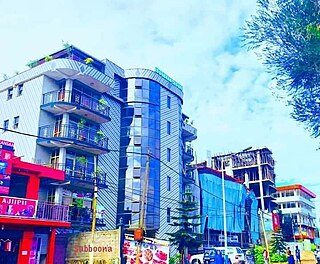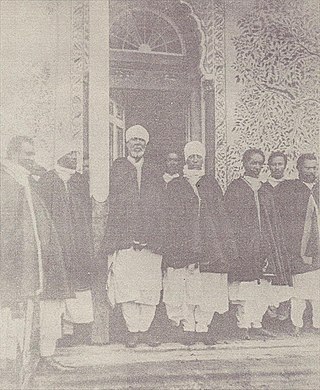
The Didessa River is a river in western Ethiopia. A tributary of the Abay River, it rises in the mountains of Gomma, flowing in a northwestern direction to its confluence where the course of the Abay has curved to its southernmost point before turning northwards at about 9°57′N35°41′E. The Didessa's drainage area is about 19,630 square kilometers, covering portions of the Benishangul-Gumuz Region and the West Welega Zone of the Oromia Region.

Welega was a province in western Ethiopia, with its capital city at Nekemte. It was named for the Wollega Oromo, who are the majority of the population within its boundaries.
This is a list of monarchies of Ethiopia that existed throughout the nation's history. It is divided into kingdoms that were subdivisions of Ethiopia, and kingdoms that were later conquered by Ethiopia. Ancient kingdoms fall into neither category.

Nekemte, also spelled as Neqemte, is a market town and separate woreda in western Ethiopia. Located in the East Welega Zone of the Oromia Region, Nekemte has a latitude and longitude of 9°5′N36°33′E and an elevation of 2,088 meters.

Prince Ermias Sahle Selassie is the only son of Prince Sahle Selassie of Ethiopia and Princess Mahisente Habte Mariam. He is the grandson of Emperor Haile Selassie of Ethiopia, and furthermore of Dejazmach Habte Mariam Gebre-Igziabiher, also known as Kumsa Moroda who was the third and last Moti, or ruler, of the Welega kingdom also referred as the Leqa Neqamte state. Moroda Bekere. Currently the prince is ninth in the line of succession to the vacant imperial throne.

Illubabor was a province in the south-western part of Ethiopia, along the border with Sudan. The name Illubabor is said to come from two Oromo words, "Illu" and "Abba Bor(a)". "Illu" is a name of a clan, and "Abba Bor" was the horse name of Chali Shone, who founded the ruling family of the area when it was conquered by Shewa; hence IlluAbabor means the Illu belonging to Ababor(a).

Princess Mahisente Habte Mariam(born at Nekemte on 9 February 1937) is the widow of Prince Sahle Selassie, youngest son of Emperor Haile Selassie of Ethiopia. She is the daughter of Dejazmach Habte Mariam Gebre-Igziabiher, also referred as Kumsa Moroda heir to the former Welega Kingdom of Leqa Naqamte, and later served as governor of Welega province. Her mother was Woizero Yeshimebet Guma, grand daughterof Moti Joté Tulu of Wesstern Welega]] [Oromo people|Oromo]] noblewoman who was later married to Ras Mesfin Selashi, a leading Ethiopian aristocrat and close associate of Emperor Haile Selassie. Princess Mahisente is also the mother of Prince Ermias Sahle Selassie, the current President of the Crown Council of Ethiopia.
Bako Tibe is one of the Aanaas, or districts, in the Oromia of Ethiopia. Part of the West Shewa Zone, Bako Tibe is bordered on the south and west by the East Welega Zone, on the north by Horo Gudru Welega Zone, and on the east by Cheliya. The administrative center of this woreda is Bako; other towns in Bako Tibe include Tibe and Shoboka.
Jimma Arjo is an Aanaa in the Oromia Regional State of Ethiopia. It shares the name of Oromo people clan, the Jimma Arjo. Part of the East Welega Zone, Jimma Arjo is bordered on the southwest by the Didessa River which separates it from the Illubabor Zone, on the northwest by Diga Leka, on the northeast by Guto Wayu, and on the southeast by Nunu Kumba. The administrative center of this woreda is Arjo.
Mendi is a town in western Ethiopia. Located in the West Welega Zone of the Oromia Region, this town has a latitude and longitude of 9°36′N35°36′E with an elevation of 1821 meters above sea level.
Nedjo is a town in western Ethiopia. Located in the West Welega Zone of the Oromia Region, this town has a latitude and longitude of 9°30′N35°30′E with an elevation of 1821 meters above sea level. It is the administrative center of Nejo woreda. Nejo is served by Nejjo Airport and is 150 km east of Asosa Airport.
The Apostolic Vicariate of Soddo is a Roman Catholic apostolic vicariate located in the city of Sodo in Ethiopia.
A horse name is a secondary noble title or a popular name for members of Ethiopian royalty; in some cases the "horse names" are the only name known for a ruler. They take the form of "father of X", where "X" is the name of the person's warhorse.
Yilma Deressa was an Ethiopian politician. He served as Finance Minister (1957–1970) and Minister of Foreign Affairs (1958-1960), Ambassador to the United States, and member of the Ethiopian Senate. John Spencer includes him in his list of five public figures who occupied the most important posts for the two decades following the Second World War.

Deressa Chimsa Edae is an Ethiopian long-distance runner who competes in marathon races. He represented Ethiopia in the event at the 2009 World Championships in Athletics. His personal best of 2:05:42 hours was set at the 2012 Dubai Marathon. He won the Daegu Marathon in 2010.
Lieka or Liekà was a former settlement in 19th and early 20th century Ethiopia, a major market town in the Oromo region southwest of Shoa. It was located on the Bilo plain, 290 kilometers southwest of Sokota and retained a hereditary Oromo ruler upon its integration into the empire of Menelek II. It has since lost its importance as a regional market to nearby Nekemte.

Ras BitwodedTessema Nadew horse name Abba Qamaw was an Ethiopian military commander and a government official who on 28 October 1909 was proclaimed as Ethiopia's future Balemulu Enderase to Lij Iyasu, upon the latter's appointment as heir to the throne by Emperor Menelik II. He died in 1911, predeceasing Menelik and thus never assuming that office. He previously served as governor of Illubabor Province, the campaign of re-conquest for which he had led, and fought in the Battle of Adwa.

The Apostolic Vicariate of Jimma–Bonga is a Roman Catholic pre-diocesan missionary jurisdiction in southwestern Ethiopia.
Bekere Godana was a king of the Leqa Neqemte one of the realms of the Oromo in the mid-19th century, ruled 1841–1868. He was the first of the kings to establish Nekemte as his capital. His rule ended in 1868 when he was succeeded by his son Moroda Bekere.








